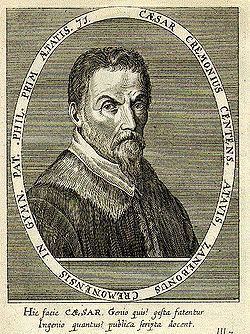Region Western philosophy Name Cesare Cremonini | Role Philosopher | |
 | ||
Era Early Modern philosophy Notable ideas Mortality of the soul, Separation of reason and faith Areas of interest Medicine, Metaphysics, Astronomy Similar People Aristotle, Averroes, Gabriel Naude, Alexander of Aphrodisias, Plotinus | ||
Cesare Cremonini, sometimes Cesare Cremonino ([ˈtʃeːzare kremoˈniːni]; 22 December 1550 – 19 July 1631) was an Italian professor of natural philosophy, working rationalism (against revelation) and Aristotelian materialism (against the dualist immortality of the soul) inside scholasticism. His Latinized name was Cæsar Cremoninus. or Cæsar Cremonius.
Contents
- Cesare cremonini marmellata 25
- Biography
- Metaphysical views
- Cremonini and Galileo
- Death and legacy
- References
Considered one of the greatest philosophers in his time, patronized by Alfonso II d'Este, Duke of Ferrara, corresponding with kings and princes who had his portrait, paid twice the salary of Galileo Galilei, he is now more remembered as an infamous side actor of the Galileo affair, being one of the two scholars who refused to look through Galileo's telescope.
Cesare cremonini marmellata 25
Biography
Cesare Cremonini was born in Cento in the then Papal States. He was a professor of natural philosophy for about 60 years:
He taught the doctrines of Aristotle, especially as interpreted by Alexander of Aphrodisias and Averroes.
He was so popular in his time that most kings and princes had his portrait and corresponded with him, sometimes consulting him about private and public affairs. At Padua, his salary was twice that of Galileo. He was especially popular among the French intellectuals who called him "le Cremonin" (the Cremonin); even a remote writer such as Jean-Louis Guez de Balzac mentioned him as "le grand Cremonin" (the great Cremonin) in his Lettres.
Metaphysical views
Following up on the controversy opened in 1516 by Pietro Pomponazzi and continued by Jacopo Zabarella (his predecessors in the chair), Cremonini too taught that reason alone cannot demonstrate the immortality of the soul – his absolute adherence to Aristotle implying that he believed in the mortality of the soul. After a paper he wrote about the Jesuits, and public statements he made in favor of laic teachers, the Jesuits in Venice accused him of materialism, then relayed their grievances to Rome. He was prosecuted in 1604 by the Inquisition for atheism and the Averroist heresy of "double truth", and ordered to refute his claims: as was his manner, Cremonini gently refused to retract himself, sheltering himself behind Aristotle's authority. Because Padua was then under tolerant Venetian rule, he was kept out of reach of a full trial.
As for the accusations, and beyond Cremonini's teachings: indeed his personal motto was "Intus ut libet, foris ut moris est" (Latin for "In private think what you wish, in public behave as is the custom"), which was taken by humanists as meaning that a scientific thinker could hold one set of opinions as a philosopher, and another set as a Christian; it was also adopted by European Libertines (brought back to France by his student and confidant Gabriel Naudé). After his death, Cremonini had his tombstone engraved with "Cæsar Cremoninus hic totus jacet" (Latin for "Here lies all of Cremonini"), implying that no soul survived.
His student Naudé (who had been his confidant for three months) qualified most of his Italian teachers as "Atheists" and especially Cremonini as a "déniaisé" ("one who has been wised up, unfoolish, devirginized", the Libertines' word for unbelievers); he added to his friends, translated, "The Cremonin, Professor of Philosophy in Padua, confessed to a few choice Friends of his that he believed neither in God, nor in Devil, nor in the immortality of the soul: yet he was careful that his manservant was a good Catholic, for fear he said, should he believe in nothing, that he may one morning cut my throat in my bed". Later, Pierre Bayle pointed out that Cremonini did not believe in the immortality of the soul (in the "Crémonin" article of his Historical and Critical Dictionary). Gottfried Leibniz, in his 1710 Theodicy, dealing with the Averroists, who "declared that man's soul is, according to philosophy, mortal, while they protested their acquiescence in Christian theology, which declares the soul's immortality", says "that very sect of the Averroists survived as a school. It is thought that Caesar Cremoninus, a philosopher famous in his time, was one of its mainstays". Pierre Larousse, in his opinionated Grand dictionnaire universel du XIXe siècle, stated Cremonini was not a Christian.
Cremonini and Galileo
At Padua Cremonini was both a rival and a friend of his colleague Galileo. When Galileo announced that he had discovered mountains on the Moon in 1610, he offered Cremonini the chance to observe the evidence through a telescope. Cremonini refused even to look through the telescope and insisted that Aristotle had definitely proved the Moon could only be a perfect sphere. When Galileo decided to move to Tuscany that year, Cremonini warned him that it would bring him under the Inquisition's jurisdiction. Indeed, the next year the Inquisition reviewed Cremonini's case for evidence against Galileo. Years later, in his book Dialogue Concerning the Two Chief World Systems, Galileo would include the character Simplicio, a dogmatic Aristotelian philosopher who was partly based on Cremonini.
Death and legacy
When Cremonini died in 1631 during the Paduan outbreak of the Italian Plague of 1629-1631, more than 400 students were working with him. His previous students included, alphabetically:
He was buried in the Benedictine monastery of St. Justina of Padua (to which he also willed his possessions). His name has been given to several streets ("via Cesare Cremonini" in Cento, "via Cesare Cremonino" in Padua) and an institute ("Istituto Magistrale Cesare Cremonini" in Cento).
